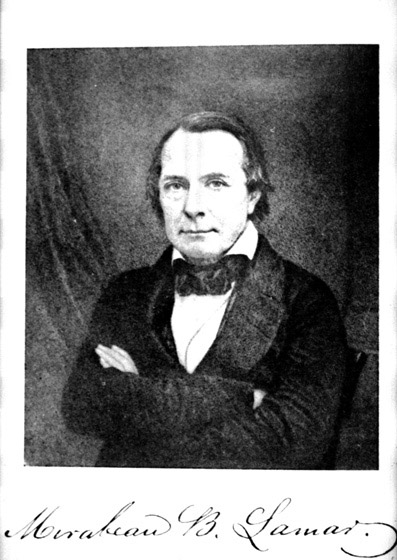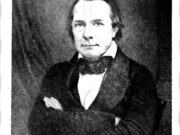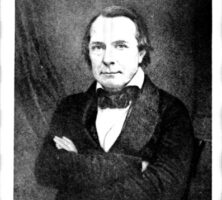Georgia native Mirabeau B. Lamar, a state senator, journalist, poet, and soldier, served as the second president of the Republic of Texas, from 1838 to 1841.

Reprinted by permission of Institute of Texan Cultures, # 068-0069, source unknown
Mirabeau Buonaparte Lamar was born on August 16, 1798, near Louisville, to Rebecca and John Lamar. He attended public school in Eatonton and Milledgeville but, due to financial concerns, decided to forgo college. In 1819 he opened a general store with partner Willis Roberts in Cahawba, Alabama, and purchased an interest in the Cahawba Press newspaper. After the demise of both the store and paper, Lamar returned to Georgia, where he accepted a job as secretary to newly elected Governor George Troup in 1823; he also became a member of Troup’s household. In 1826 he married Tabitha Jordan, of Twiggs County, and they had one daughter, Rebecca Ann. At the end of Troup’s second gubernatorial term, Lamar and his family moved to Columbus and established the Columbus Enquirer (later the Columbus Ledger-Enquirer). The newspaper adhered to the states’ rights principles supported by Lamar and his mentor Troup.
In 1829 Lamar ran for and was elected to the Georgia senate. He decided not to run for a second term when, on August 20, 1830, his wife died of tuberculosis. Lamar left the state, traveling to overcome his grief, but in 1832 he returned to Georgia to run for office in the U.S. House of Representatives. The party caucus members refused to place his name into nomination, however, and he was defeated as an independent candidate. After a second unsuccessful run for Congress and the suicide of his brother, Lucius Q. C. Lamar, Lamar sold his stake in the Columbus Enquirer and left Georgia for Texas.
Lamar arrived in Texas in July 1835, and although he initially intended to write a history of Texas, he eventually decided to join the Texas army in the fight for independence from Mexico. Soon after entering combat, Lamar was responsible for saving the life of future Texas senator Thomas J. Rusk. He was then promoted to head the cavalry during the April 1836 Battle of San Jacinto, in which the Texans soundly defeated the Mexicans. Following his success in battle, Lamar was named secretary of war in the Texas provisional government. In 1836 he was elected vice president of the new Republic of Texas under President Sam Houston, and he succeeded Houston as president of the republic in 1838.
Upon taking office, Lamar was faced with a myriad of problems. He inherited significant debt from the previous administration and due to the Panic of 1837 was unable to secure a substantial loan to support the government. Lamar sent an expedition to Santa Fe (at the time a capital of Mexico, and later the capital of New Mexico) in an attempt to create a trade network, but the expedition was eventually taken captive by Mexican forces. Foreign policy proved to be a challenge for Lamar’s administration as well. During his presidency Lamar was unable to secure a lasting peace with Mexico, despite numerous diplomatic attempts. The Texas Republic also faced constant fighting with the Cherokee and Comanche Indian populations. In response, Lamar ordered the expulsion of the Cherokee people from eastern Texas; the Cherokee dispersed mostly to Indian Territory (present-day Oklahoma), Arkansas, and Mexico. Although he attempted to address the Comanche with military force, Lamar was unable to remove them as a threat.
Despite the numerous setbacks, Lamar was responsible for several significant accomplishments during his presidency. He was able to gain diplomatic recognition from several European countries, oversaw the establishment of the state capital in Austin, and promoted the passing of the Texas Homestead Act, which encouraged immigration to the state. His most enduring legacy as president of Texas, however, was his contribution to the state’s educational system. During his administration, Lamar pushed for lands to be set aside to fund public schools and universities throughout the state. His actions earned him the nickname the”Father of Texas Education.”
After the end of his term in office, Lamar retired to his plantation in Richmond, Texas. Upon the outbreak of the Mexican War (1846-48), he joined the fighting ranks and was named inspector general of General Zachary Taylor’s forces. He was eventually promoted to lieutenant colonel after his participation in the Battle of Monterrey in Mexico in 1847. Toward the end of the war, Lamar helped organize the San Patricio and Nueces County governments in southern Texas and was elected to represent those counties in the state legislature in 1847.
In 1851 Lamar married his second wife, Henrietta Maffitt. He later published a collection of poetry called Verse Memorials (1857), which included poems he had written throughout his adult life. In 1857 U.S. president James Buchanan appointed Lamar ambassador to Nicaragua and Costa Rica, an office he held for less than two years. A few months after his return home to Richmond, Lamar died of a heart attack on December 19, 1859.





